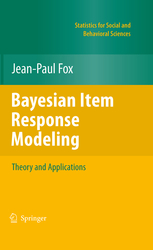
Bayesian Item Response Modeling:Theory and Applications
Fox, Jean-Paul
2010, XIV, 313p.
- Serves as a handbook for measurement specialists and a textbook for students on the Bayesian approach to modern test theory.
- Acts as a guide to the authors’ computer software implementations that will be made available via a website.
- Includes software implementations available in S-Plus and R, with new functions built on Fortran code linked to the S-plus and R environments, for time efficiency.
- Self-contained introduction to Bayesian item response modeling and a coverage of extending standard models to handle complex assessment data
- A thorough overview of Bayesian estimation and testing methods for item response models, where MCMC methods are emphasized
- Numerous examples that cover a wide range of application areas, including education, medicine, psychology, and sociology
- Datasets and software (S+, R, and WinBUGS code) of the models and methods presented in the book are available on www.jean-paulfox.com Bayesian Item Response Modeling is an excellent book for research professionals, including applied statisticians, psychometricians, and social scientists who analyze item response data from a Bayesian perspective. It is a guide to the growing area of Bayesian response modeling for researchers and graduate students, and will also serve them as a good reference. Jean-Paul Fox is Associate Professor of Measurement and Data Analysis, University of Twente, The Netherlands. His main research activities are in several areas of Bayesian response modeling. Dr. Fox has published numerous articles in the areas of Bayesian item response analysis, statistical methods for analyzing multivariate categorical response data, and nonlinear mixed effects models.
本帖隐藏的内容
 Bayesian IRT.pdf
(4.14 MB, 需要: 25 个论坛币)
Bayesian IRT.pdf
(4.14 MB, 需要: 25 个论坛币)
http://www.jean-paulfox.com/index.php?option=com_content&view=category&id=5&layout=blog&Itemid=3







 雷达卡
雷达卡





 提升卡
提升卡 置顶卡
置顶卡 沉默卡
沉默卡 变色卡
变色卡 抢沙发
抢沙发 千斤顶
千斤顶 显身卡
显身卡







 京公网安备 11010802022788号
京公网安备 11010802022788号







